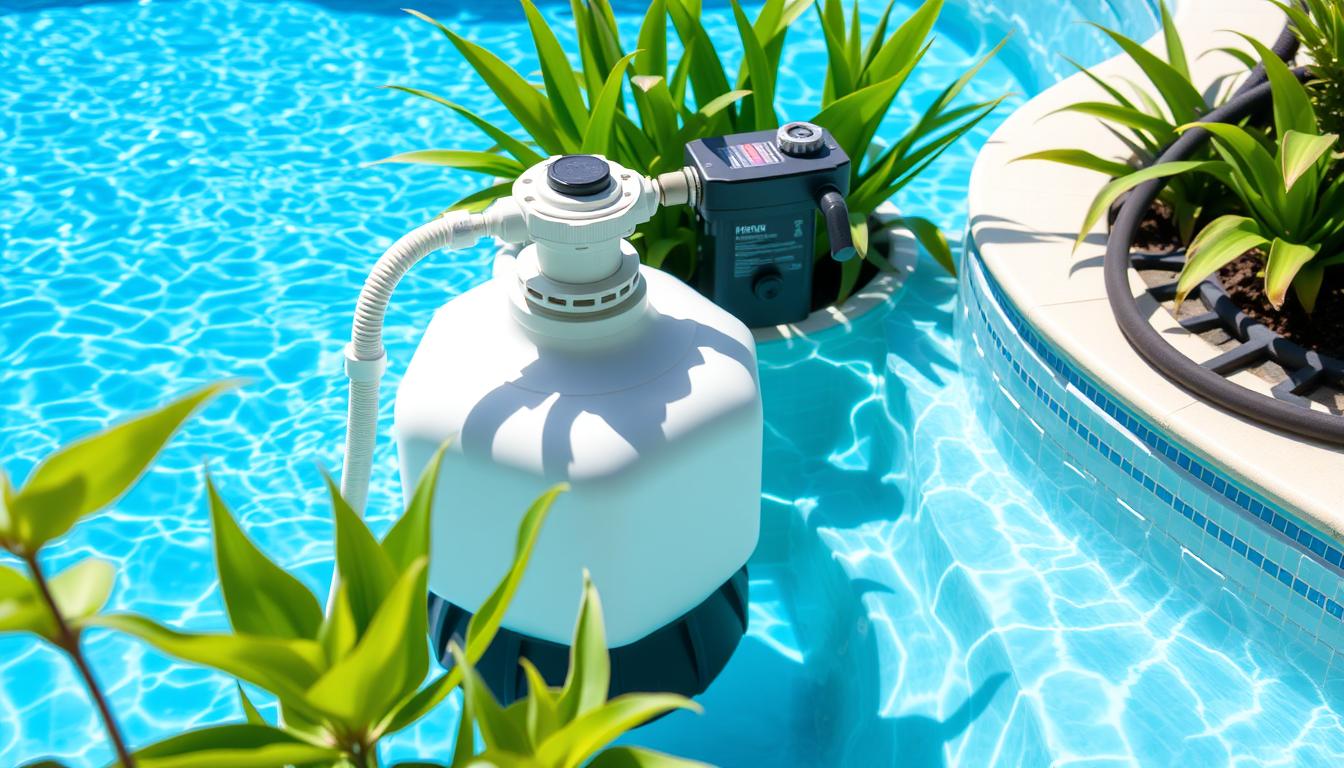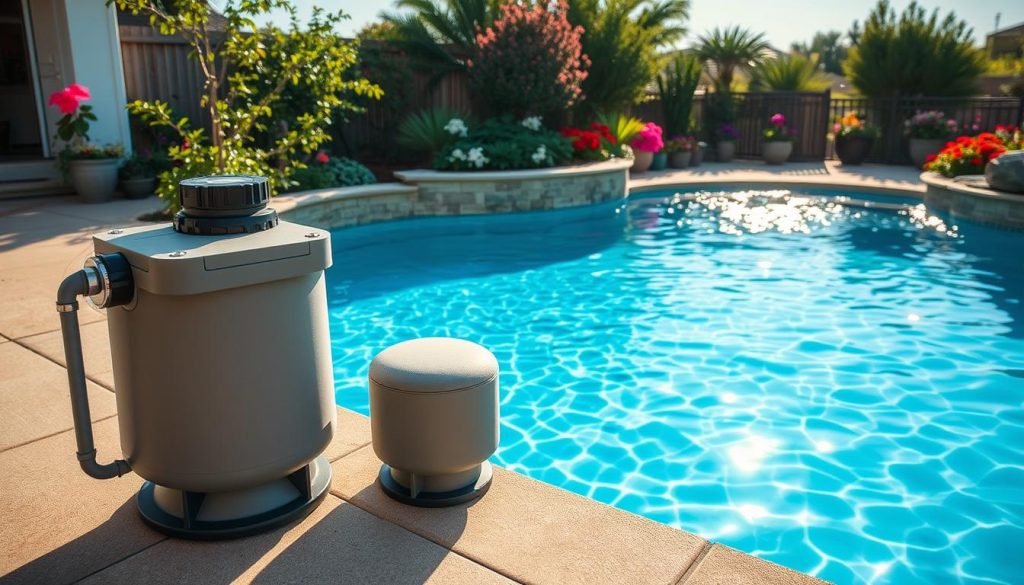
Sand filters can hold up to 250 pounds of special filter sand. They’re an efficient and cost-effective choice for pool water treatment. However, they work best when combined with proper pool sanitization.
Sand filters trap dirt and tiny particles as water flows through them. This process results in clean water returning to your pool. But chlorine is still vital for sanitization and pool water safety.
Balancing sand filter maintenance and chlorine levels is key. This balance keeps your pool in great shape. You’ll enjoy refreshing swims all season long.
How Sand Filters Work to Keep Your Pool Clean
Sand filters are popular among pool owners for their effectiveness. They use special sand to trap particles and debris. As the filter gets dirtier, it traps more unwanted particles.

The Role of Sand Filters in Pool Maintenance
Sand filters are crucial for keeping pools clean and hygienic. They capture particles as small as 20 to 100 microns. This includes dirt, debris, and some microscopic organisms.
Over time, the filter’s ability to trap particles improves. However, periodic backwashing is necessary to remove trapped contaminants. This helps maintain optimal filtration performance.
Most pools benefit from a sand filter change every two to three years, depending on pool usage and sand quality. Cloudy water, old sand leading to channeling, and ineffective chemical treatments can all indicate the need for a sand filter change.
Advantages of Sand Filters over Other Filtration Systems
Sand filters offer several advantages compared to cartridge and diatomaceous earth (DE) filters:
- Lower maintenance costs
- Less frequent cleaning requirements
- Longer lifespan (5-7 years) before needing to replace the sand
- Easy to operate and maintain
- Effective at removing a wide range of contaminants
| Filter Type | Average Lifespan | Cleaning Frequency |
|---|---|---|
| Sand Filters | 3-7 years | Backwash when pressure rises 8-10 psi |
| Cartridge Filters | 2-4 years (2,000 working hours) | Clean once a week |
| Glass Filters | 7-15 years | Backwash when pressure rises 8-10 psi |
Understanding sand filters helps pool owners make smart choices. They can maintain their pool equipment better. This leads to clearer water and better hygiene.
The Importance of Chlorine in Pool Sanitization
Chlorine is vital for keeping pools safe and healthy. It kills bacteria, pathogens, and other harmful microorganisms in the water. Without it, pools would become breeding grounds for germs and algae.
How Chlorine Works to Kill Bacteria and Pathogens
Chlorine forms hypochlorous acid in pool water. This powerful disinfectant targets and neutralizes bacteria, viruses, and other microorganisms. It disrupts their cellular functions, making them inactive and unable to reproduce.
Chlorine doesn’t remove contaminants from water. Instead, it creates chloramines, causing the “chlorine smell” in pools. High chloramine levels can reduce chlorine’s effectiveness, signaling the need for pool shocking.
Maintaining Proper Chlorine Levels in Your Pool
Keep free chlorine levels between 1 and 3 parts per million (ppm). Check regularly with a reliable pool water testing kit. Adjust by adding chlorine or reducing stabilizer as needed.
| Type of Chlorine | Form | Characteristics |
|---|---|---|
| Dichlor | Granular | Stabilized, dissolves quickly |
| Trichlor | Tablets or sticks | Stabilized, slow-dissolving |
| Sodium Hypochlorite | Liquid | Unstabilized, highly concentrated |
| Lithium Hypochlorite | Granular | Unstabilized, fast-dissolving |
| Calcium Hypochlorite | Granular or tablets | Unstabilized, slow-dissolving |
Run your pool pump long enough to produce sufficient chlorine. This compensates for daily loss and maintains free chlorine levels. Monitor and adjust chlorine levels regularly for a safe, enjoyable swimming experience.
Do You Need Chlorine with a Sand Filter
Sand filters are great at removing physical contaminants from pool water. However, they’re not enough to ensure pool water safety and cleanliness. Chlorine is still necessary when using a sand filter system.
The Relationship Between Sand Filters and Chlorine
Sand filters and chlorine work together for a healthy swimming environment. These filters trap dirt and debris down to 20-40 microns in size. However, they can’t eliminate harmful bacteria and viruses that cause illnesses.
Chlorine is the powerful sanitizer that kills these pathogens. It prevents their growth in the water, keeping swimmers safe from various health issues.
Ensuring Optimal Pool Water Quality and Safety
For best results, maintain both a working sand filter and proper chlorine levels. Backwash the filter when pressure rises by 10 psi. Replace the sand every 5-7 years for efficient contaminant removal.
Monitor and adjust chlorine levels based on bather load and weather conditions. This helps prevent waterborne illnesses. Using both methods creates a safe, fun swimming environment for everyone.







